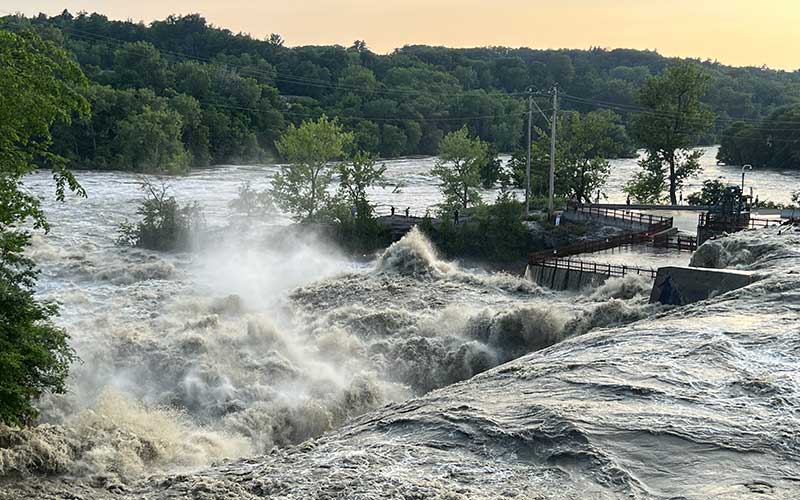
The Flood Safety Act aims to better protect Vermonters from devastating floods like those we experienced in July and December of 2023. Photo: Julie Silverman
In early February, I was headed home with our children from school pick-up. Several feet of snow covered the ground, but an eerie spring-like fog surrounded us. The unseasonably warm air smelled of the ocean. Several days of downpours were causing rising floodwaters, and we could hear each passing waterway raging. It was too close for comfort to the catastrophic flooding we experienced in July and December 2023, when rivers overran their banks and entire communities found themselves underwater.
As we picked our way along muddy dirt roads marked with deep ruts, we saw a neighbor approaching from the other direction. As Vermonters often do, we stopped, turned off the engines, and chatted in the dwindling daylight. The conversation flowed toward the unusual weather, the nearby rivers spilling their banks, our now-multiple mud seasons, and a changing climate. He asked: “What’s the State doing about it up in Montpelier?” I told him about the Flood Safety Act, which he’d heard about on the news.
“Isn’t that just the State once again telling Vermonters what we can and can’t do?” “Respectfully, no” I replied, and explained why. After some back and forth about the bill’s intent, he said, “Wow, they’re actually really trying to help Vermonters, the environment, and our public safety.”
And that’s exactly right! At its core, the Flood Safety Act aims to improve our flood preparedness, our ability to bounce back from climate disasters, and our water quality – while reducing taxpayer-funded flood recovery. Here’s how, and how you can help get it to the governor’s desk.
Let’s start from the beginning: What’s the problem?
It is no secret that Vermont communities are experiencing flooding at higher frequencies, greater devastation, and exponential costs. Scientists project that climate change will spark more frequent floods like those we lived through last year – and that they will occur with an increasingly harmful intensity in the future.
Unfortunately, many of our existing laws and programs simply aren’t up to the task of adequately protecting Vermonters in an era of climate change. We urgently need visionary and proactive regulatory efforts that increase the State’s ability to protect communities from climate-related disasters and help Vermonters bounce back from them more quickly.
And that’s exactly what the sponsors of the Flood Safety Act set out to accomplish. The bill thoughtfully overhauls and designs new policies that reduce the likelihood and damage caused by future flooding. The bill also promotes clean water, biodiversity preservation, and recreational opportunities that support local economies. By moving this legislation forward, we can enhance public safety, lessen the impacts and costs of flood damage, and safeguard our waterways and natural resources from the escalating impacts of climate change.
What are the moving parts of the Flood Safety Act?
Here’s a quick flyover summary of what’s currently in the bill:
- River Corridor Protections: River corridors are the meandering area of a river prone to high-hazard erosive flooding that accounts for 80% of flood-related damages. River corridors allow space for floodwaters to slow and spread out, which also makes development in them especially vulnerable to flood damage and causes health and safety hazards downstream. The proposed bill will ensure that future development strategically avoids high-hazard river corridors through statewide regulations developed with robust public input. This will allow rivers the space needed to overflow while minimizing public health and safety downstream.
- Wetland Protections: Healthy wetlands play a critical role in mitigating flood risks by acting as sponges and absorbing floodwaters. The Flood Safety Act calls for improved mapping and reporting of wetlands. The bill also establishes a two-to-one “net gain” policy. This means that when the destruction of a wetland is unavoidable, the actor must ensure an overall gain (at a two-to-one ratio) in lost habitat by restoring or creating new habitats as a result of the development process. This is intended to reverse historic wetland loss, which is a major factor in the increased flooding we have experienced in recent years.
- Dam Safety: The bill will strengthen oversight and maintenance requirements for dam owners. It will also invest in the strategic removal of dams that are worsening flooding. Together, these measures will enhance public safety by reducing flood risks from existing dams.
- Plastic Foam Marine Debris: The bill will proactively prevent one of the leading causes of toxic polystyrene foam (worsened by climate change) from entering Vermont’s waterways, killing wildlife, polluting beaches, and degrading water quality at large.
What’s next and how can you help?
On Wednesday, March 20, the Vermont Senate voted to advance the Flood Safety Act with strong bipartisan support. Senators gave it a final approval by voice vote the next day. The Flood Safety Act is now in the Vermont House where the House Committee on Energy and the Environment expects to begin taking testimony on the bill this week.
If you’d like to help, we encourage you to take a few minutes to call or email your representative(s) and senator(s). Ask them to support S.213 to help protect Vermont from future floods and other climate disasters.
We may not be able to avoid some of the future risks from climate change, but we can take steps now to better protect our communities, our homes, and our families. Thank you for speaking up and taking action.




